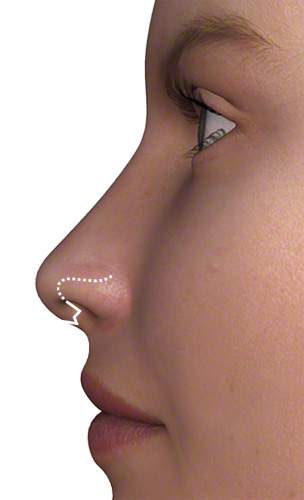The procedure to correct the nasal septum can be performed for medical reasons.
If there is a curvature of the septum, which can be hereditary or the result of injury, this can lead to nasal obstruction.
Even minor injuries in childhood can lead to cracks in this wall, causing it to grow unevenly as the child grows. This results in a curvature.
Nasal septum surgery is also often necessary for cosmetic rhinoplasty. At Yuveo Düsseldorf, we will operate on a deviated septum for cosmetic reasons if it leads to a crooked nose.
In principle, nasal septum surgery is part of every rhinoplasty surgeon’s standard repertoire as a single operation or as part of a cosmetic nose operation.
Contents
Yuveo Clinic
Special features of nasal septum surgery
Cosmetic and medical reasons lead to a correction of the nasal septum.
Medical reasons
Aesthetic reasons
Formerly tamponades, today silicone splints
The operation to straighten the nasal septum
At the Yuveo Clinic in Düsseldorf, we proceed as follows during the operation:
Incision for nasal septum surgery
We make an incision near the bridge of the nose to expose the cartilage from there. Ideally, we prepare underneath the cartilage skin, as no bleeding can occur here and the membrane can be easily separated. Existing scars can make the procedure more difficult.
Extent of the correction
The area to be exposed depends on how large the malformation is. After fractures of the septum, sharp edges may need to be repaired or some small corners may protrude into the nasal cavity and thus disrupt the circulation of the air we breathe.
Rare: external straightening of the septum
In rare cases, it may also be necessary to expose the entire nasal septum during the operation and remove it completely. In this case, our plastic surgeons perform the correction of the septum externally and then reinsert it.

Frequently asked questions about nasal septum surgery
Is the deviated septum always the sole cause of a respiratory obstruction?
If a deviated septum causes nasal obstruction, nasal septum surgery will usually result in better breathing.
If the nasal obstruction is caused by chronic inflammation of the nasal mucosa with proliferation of the nasal mucosa due to turbinates protruding far into the nasal cavity, then surgery on the nasal septum alone will not completely alleviate the symptoms.
Especially if a combination of different factors is the cause of a nasal breathing disorder, then a simple nasal septum operation will rarely be sufficient.
What happens after the operation?
The follow-up treatment for nasal septum surgery depends on the extent of the procedure.
After the smallest intervention
As part of a rhinoplasty, we shorten the lower front section of the nose and lift the tip of the nose.
-> The follow-up treatment is the same as for cosmetic rhinoplasty.
After medium surgery
This involves the restoration of the nasal septum after cartilage has been removed for the rhinoplasty.
It is similar in the case of a slight misalignment, when small to medium-sized sections of cartilage are incised, grated or removed.
-> The small foam nasal tampons are only left in place overnight. A so-called septum splint is inserted, which usually remains in place for 1 week. This consists of two small plates, usually made of silicone. These are loosely fixed with sutures that run through both splints and through the nasal septum.
A nasal plaster is usually also used and remains in place for approx. 14 days, depending on the operation.
After major surgery
Follow-up treatment is more complex after major reconstruction of the nose, which requires a lot of donor cartilage from the septum.
The donor area of the costal arches is suitable for the nasal septum itself.
-> The nasal septum splints usually remain in place for much longer.
We also like to use splints that have an additional tube (usually also made of silicone) to ensure ventilation in the event of severe swelling, bleeding or incrustation.
Fact check
- Practitioner: Dr. Schumann
Treatment duration:
about 45 minutes to 2 hours- Anesthesia:
General anesthesia - Hospital stay:
1 day inpatient - Aftercare:
Cooling, elevating the upper body, silicone splints, one week or longer, nasal plaster (depending on the extent of the operation) - Sport:
The nose is sensitive to impact. No sport for 4 to 6 weeks after surgery. - Costs: on request
Further information and related topics
- Details of the surgery
- The nasal septum provides donor cartilage for other operations on the nose.
- Silicone splint instead of tamponade
Technical terms:
- Deformity = malformation
- Perichondrium = cartilage membrane
- Septum splints = silicone splints that stabilize the nasal septum after surgery


